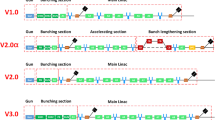Abstract
Purpose
The High Energy Photon Source is a fourth-generation synchrotron radiation source being built in China. It is comprised of a storage ring, a full energy booster, a 500-MeV Linac and three transport lines. The pulse charge at the exit of the Linac is required to be up to 7 nC. Both single bunch and three bunches in a beam pulse might be needed according to the studies on instabilities of the booster and the beam dynamic of the main Linac.
Methods
A bunching system consisting of both sub-harmonic and fundamental frequency structures is designed to meet the requirements. To obtain high transmission efficiency and control the emittance growth, multi-objective genetic algorithm is introduced to optimize the electromagnetic parameters of these structures.
Results
In this paper, detailed optimization process and the final results are presented. The total transmission efficiency of the bunching system is 97%, and the transmission efficiency of the main bunch is 95%. The normalized RMS emittance of 8.5 nC included beam charge is smaller than 60 mm mrad.
Conclusions
The design of the bunching system is presented, and both the pulse charge and the beam emittance well meet the design requirement.










Similar content being viewed by others
References
Y. Jiao et al., The HEPS project. J. Synchrotron Radiat. 25, 1611–1618 (2018)
S. Pei et al., Physical design of the 500 MeV electron Linac for the high energy photon source, in Proceedings of 9th International Particle Accelerator Conference (IPAC’18) (Vancouver, Canada, 2018), pp. 1404–1406. https://doi.org/10.18429/jacow-ipac2018-tupmf061
Y.M. Peng et al., Status of HEPS booster lattice design and physics studies, in Proceedings of 9th International Particle Accelerator Conference (IPAC’18) (Vancouver, Canada, 2018), pp. 1407–1410. https://doi.org/10.18429/jacow-ipac2018-tupmf062
G. Xu et al., Progress of lattice design and physics studies on the high energy photon source, in Proceedings of 9th International Particle Accelerator Conference (IPAC’18) (Vancouver, Canada, 2018), pp. 1375–1378. https://doi.org/10.18429/jacow-ipac2018-tupmf052
Y.Y. Guo, Z. Duan, Y. Jiao, Y.M. Peng, G. Xu, High energy transport line design for the HEPS project, in Proceedings of 8th International Particle Accelerator Conference (IPAC’17) (Copenhagen, Denmark, 2017), pp. 1466–1468. https://doi.org/10.18429/jacow-ipac2017-tupab063
Y.M. Peng, C. Meng, H.S. Xu, Physical design of HEPS low energy transport line, in Proceedings of 10th International Particle Accelerator Conference (IPAC’19) (Melbourne, Australia, 2019), pp. 2349–2352. https://doi.org/10.18429/jacow-ipac2019-wepmp019
J.L. Li et al., Conceptual design of HEPS injector, in Proceedings of 9th International Particle Accelerator Conference (IPAC’18) (Vancouver, Canada, 2018), pp. 1394–1397. https://doi.org/10.18429/jacow-ipac2018-tupmf058
C. Meng, Y. Jiao, J.L. Li, S. Pei, Y.M. Peng, H.S. Xu, Design of bunch lengthening system in electron Linac, in Proceedings of 9th International Particle Accelerator Conference (IPAC’18) (Vancouver, Canada, 2018), pp. 1401–1403. https://doi.org/10.18429/jacow-ipac2018-tupmf060
C. Meng et al., The progress in physics design of HEPS LINAC, in Proceedings of 10th International Particle Accelerator Conference (IPAC’19) (Melbourne, Australia, 2019), pp. 1008–1011. https://doi.org/10.18429/jacow-ipac2019-mopts067
Y.M. Peng, J.L. Li, C. Meng, S. Pei, H.S. Xu, The considerations of improving TMCI threshhold on HEPS booster, in Proceedings of 9th International Particle Accelerator Conference (IPAC’18) (Vancouver, Canada, 2018), pp. 1411–1413. https://doi.org/10.18429/jacow-ipac2018-tupmf063
K. Deb et al., A fast elitist multi-objective genetic algorithm: NSGA-II. IEEE Trans. Evol. Comput. 6(2), 182–197 (2002)
L.M. Young, J.H. Billen, Parmela, LA-UR-96-1835
W.B. Herrmannsfeldt, EGUN: an electron optics and gun design program, SLAC-331 (1988)
V. Bagini et al., Propagation of axially symmetric flattened Gaussian beams. J. Opt. Soc. Am. A 13(7), 1385–1394 (1996)
Acknowledgements
The authors would like to thank all the colleagues in HEPS project for fruitful discussions. This study was supported by National Natural Science Foundation of China under Grants (11705214, 11675174) and Youth Innovation Promotion Association CAS (2019016).
Author information
Authors and Affiliations
Corresponding author
Rights and permissions
About this article
Cite this article
Zhang, S., Wang, S., Meng, C. et al. The physics design of HEPS Linac bunching system. Radiat Detect Technol Methods 4, 433–439 (2020). https://doi.org/10.1007/s41605-020-00200-1
Received:
Revised:
Accepted:
Published:
Issue Date:
DOI: https://doi.org/10.1007/s41605-020-00200-1




